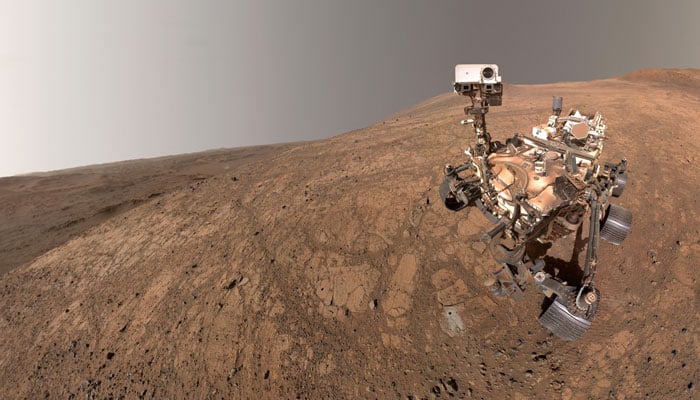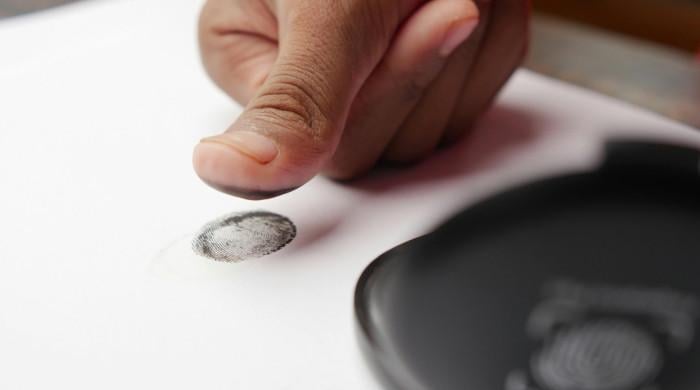Nasa rover detects 'mini-lightning' on Mars
"It sounded like a spark or whip-crack," says planetary scientist
November 26, 2025

WASHINGTON: NASA's Perseverance rover has obtained evidence that the atmosphere of Mars is electrically active, detecting electrical discharges — what one scientist called "mini-lightning" — often associated with whirlwinds called dust devils that regularly saunter over the planet's surface.
The six-wheeled rover, exploring Mars since 2021 at a locale called Jezero Crater in its northern hemisphere, picked up these electrical discharges in audio and electromagnetic recordings made by its SuperCam remote-sensing instrument, researchers said.
It is the first documentation of electrical activity in the thin Martian atmosphere.
"These discharges represent a major discovery, with direct implications for Martian atmospheric chemistry, climate, habitability and the future of robotic and human exploration," said planetary scientist Baptiste Chide of the Institute for Research in Astrophysics and Planetology in France, lead author of the study published on Wednesday in the journal Nature.
"The electrical charges required for these discharges are likely to influence dust transport on Mars, a process fundamental to the planet's climate and one that remains poorly understood. What's more, these electrostatic discharges could pose a risk to the electronic equipment of current robotic missions - and even a hazard for astronauts who one day will explore the Red Planet," Chide said.
The researchers analysed 28 hours of microphone recordings made by the rover over a span of two Martian years, detecting 55 electrical discharges, usually associated with dust devils and dust storm fronts.
"We did not detect lightning by the common definition. It was a small spark, perhaps a few millimetres long, not really lightning. It sounded like a spark or whip-crack," said planetary scientist and study co-author Ralph Lorenz of the Johns Hopkins University Applied Physics Laboratory in Maryland.
Sixteen of the electrical discharges were recorded during Perseverance's two close encounters with dust devils.
Another study published in October documented how dust devils are a common feature on dry and dusty Mars, with two orbiting spacecraft detecting wind speeds reaching around 98 miles per hour (158 km/h) in these whirlwinds that hoist dust into the atmosphere.
The internal dynamics of dust devils give rise to the electrical discharges.
"I would call it 'mini-lightning,'" Chide said. "The phenomena are caused by the friction of tiny dust grains rubbing against each other in the air, which builds up electrons and then releases their charge as electrical arcs just a few centimetres long, accompanied by audible shockwaves."
The phenomenon is called triboelectricity.
"Think of a sunny, dry day when you walk on a rug or a rubber surface and bring your hand close to a door handle. The small spark you might generate, and thus experience, is the same kind of electrostatic discharge that we detected with SuperCam on Perseverance," said planetary scientist and study co-author Franck Montmessin of the French research agency CNRS and research laboratory LATMOS.
Electrical activity in the Martian atmosphere had long been suspected.
"What we've observed is a result of having exceptionally sensitive instrumentation observing for a long period, so we can detect very small discharges, about the energy of an automobile ignition," Lorenz said.
Mars joins Earth, Saturn and Jupiter as planets known to have atmospheric electrical activity. Though not yet documented, other worlds in our solar system also may have this feature including the planets Venus and Uranus and Saturn's moon Titan, according to the researchers.
"The Mars atmosphere was looking very favourable for electrification: full of dust, dry and turbulent," Chide said.
"On terrestrial deserts on Earth, the electrification of dust and sand is well-documented, but it rarely results in actual electrical discharges. On Mars, however, the thin carbon dioxide atmosphere makes this phenomenon far more likely, as the amount of charge required to generate sparks is much lower than it is on Earth."
SuperCam recorded the very first Martian sounds in 2021, shortly after Perseverance landed.
"Since then, it has been used daily to listen to the atmosphere, compiling a playlist of over 30 hours of sounds from the Red Planet: the howl of the wind, the whir of the (rover-deployed) helicopter Ingenuity's blades, and now, a new track: electrostatic discharges," said Chide.









